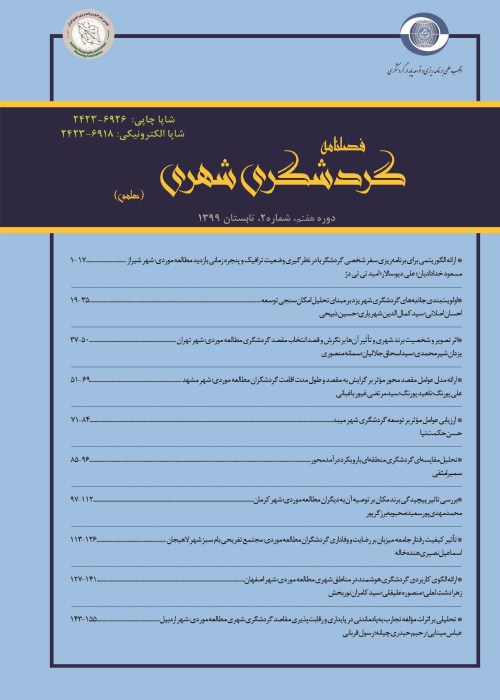Practical Pattern of Smart Tourism in Urban AreasCase Study: Esfahan City
The development of information and communication technology has created a "new generation" of tourism that people have important demands, such as tracking travel arrangements and plans, searching for information, online booking tickets and hotels, online shopping, and comparing travel prices, providing mobile facilities and applications (Wi-Fi, short-term services and multimedia messaging), and also have less inclined to wait or delay and time is of value to them. Under these situations, to reduce the gap between the real world and the digital realm, smart tourism has emerged as an acceptable response to these structural changes. Following this trend, the main issue is that Iran has not yet taken appropriate and constructive measures and decisions in the field of smart tourism, and so far no suitable model has been presented in terms of it. The importance of the subject is that smart tourism helps tourists to expand the domain of their tourism experience by creating an environment for sharing information and experiences without borders. According to the importance of smart tourism, the main purpose of this study is to identify smart tourism components and also provide a practical pattern of smart tourism in order to examine its effects on tourist satisfaction and co-creation.
In the current research, a combined method has been used to achieve the research objectives. In the first part of the qualitative method with inductive approach, in terms of nature, it is exploratory research and in terms of orientation, because it seeks to identify the components of smart tourism, it is a fundamental one. In the second part, SPSS 22 and Smart-PLS 2.0 software programs were used. The statistical population of this research in the qualitative stage is divided into two parts: A) experts in the field of tourism, including academic and management experts, and especially those who have scientific and educational background in the field of tourism management. Due to the limited number of these individuals, the sample was examined and interviewed theoretically (non-probability) and purposefully. B) Managers, deputies and experts of the Tourism Organization in Isfahan. The sample size of this research is 15 people. In the second part, a quantitative method was applied to investigate the effects of smart tourism on tourist satisfaction and co-creation. The validity of the research questions was accomplished in a formal way by experts and its reliability was calculated based on Cronbach's alpha that was obtained 0.823, which indicates the appropriate reliability of the research questions.
Thereafter in-depth interviews with the expert group, 83 concepts, 19 main categories and 11 components for smart tourism were identified and extracted. The extracted categories were structured according to the Strauss and Corbin paradigm model in the form of six dimensions of causal conditions, intervening factors, contextual factors, interaction dimension or strategies of action, outcome and phenomenon. Reliability tests (Cronbach's alpha and composite reliability) and validity tests (convergent and divergent validity methods) were used to measure the fit of the reflective measurement model. Based on the results of the obtained measurement model, the factor load has a value greater than 0.5 in all cases, which indicates that there is an appropriate correlation between observable and latent variables. To evaluate the divergent validity of the measurement model, Fornell and Larker criterion was exerted and confirmed. Furthermore, in order to assess the quality or validity of the model, a validity check was used, which includes a subscription validity index and a redundancy validity index. According to the results, the effect of smart tourism on co-creation has been calculated to be 0.262. And the probability statistic of the test has been obtained 4.441. Also, the intensity of the effect of smart tourism on tourist satisfaction is calculated to be 0.231 and the probability statistic of the test has been obtained 3.890.
According to the obtained results from Smart-PLS software program, it was found that smart tourism has a positive effect on tourist co-creation. Therefore, it can be concluded that tourists through smart approach can actively engage with tourism service providers and cooperate in creating co-creation and also they may even be directly involved in tourism proposals innovation. Based on the result of the positive and significant effect of smart tourism path coefficient on tourist satisfaction, it can be said that tourist satisfaction plays an important role in the continuation of tourism and the future of this industry. The results of this study also demonstrated that the type and amount of received information is directly related to travel planning.
- حق عضویت دریافتی صرف حمایت از نشریات عضو و نگهداری، تکمیل و توسعه مگیران میشود.
- پرداخت حق اشتراک و دانلود مقالات اجازه بازنشر آن در سایر رسانههای چاپی و دیجیتال را به کاربر نمیدهد.


